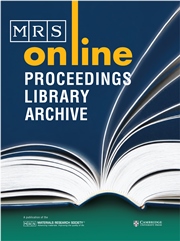No CrossRef data available.
Article contents
Thickness-fringe Contrast Analysis of Defects in GaN
Published online by Cambridge University Press: 18 March 2011
Abstract
The analysis of thickness-fringe contrast in weak-beam transmission electron microscope (TEM) images has been shown to be a reliable method for the complete determination of the character, as well as the magnitude, of a dislocation Burgers vector. By selecting multiple diffraction conditions and, for each condition, determining the number of terminating thickness fringes at the exit of a dislocation from a wedge-shaped sample, the Burgers vector can be unambiguously determined. Defect analysis of GaN pyramids grown on (111)Si by the lateral epitactic overgrowth (LEO) technique reveals a core region which contains a relatively high density of dislocations and a lateral-growth region where the defect density is decreased. The thickness-fringe contrast technique was used in the lateral growth regions of the pyramids to analyze the dislocation Burgers vectors.
Information
- Type
- Research Article
- Information
- Copyright
- Copyright © Materials Research Society 2001

